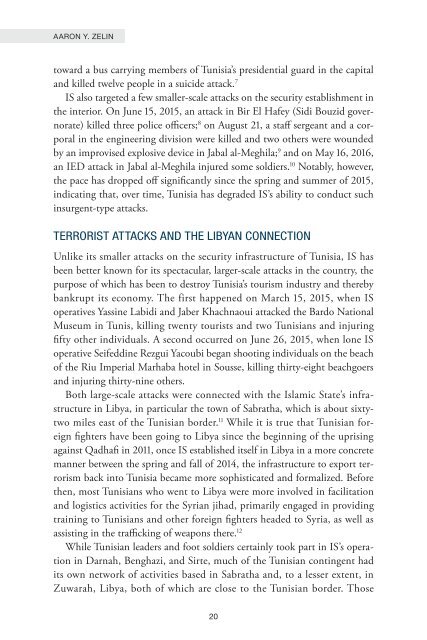You also want an ePaper? Increase the reach of your titles
YUMPU automatically turns print PDFs into web optimized ePapers that Google loves.
AARON Y. ZELIN<br />
toward a bus carrying members of Tunisia’s presidential guard in the capital<br />
and killed twelve people in a suicide attack. 7<br />
IS also targeted a few smaller-scale attacks on the security establishment in<br />
the interior. On June 15, 2015, an attack in Bir El Hafey (Sidi Bouzid governorate)<br />
killed three police officers; 8 on August 21, a staff sergeant and a corporal<br />
in the engineering division were killed and two others were wounded<br />
by an improvised explosive device in Jabal al-Meghila; 9 and on May 16, 2016,<br />
an IED attack in Jabal al-Meghila injured some soldiers. 10 Notably, however,<br />
the pace has dropped off significantly since the spring and summer of 2015,<br />
indicating that, over time, Tunisia has degraded IS’s ability to conduct such<br />
insurgent-type attacks.<br />
TERRORIST ATTACKS AND THE LIBYAN CONNECTION<br />
Unlike its smaller attacks on the security infrastructure of Tunisia, IS has<br />
been better known for its spectacular, larger-scale attacks in the country, the<br />
purpose of which has been to destroy Tunisia’s tourism industry and thereby<br />
bankrupt its economy. The first happened on March 15, 2015, when IS<br />
operatives Yassine Labidi and Jaber Khachnaoui attacked the Bardo National<br />
Museum in Tunis, killing twenty tourists and two Tunisians and injuring<br />
fifty other individuals. A second occurred on June 26, 2015, when lone IS<br />
operative Seifeddine Rezgui Yacoubi began shooting individuals on the beach<br />
of the Riu Imperial Marhaba hotel in Sousse, killing thirty-eight beachgoers<br />
and injuring thirty-nine others.<br />
Both large-scale attacks were connected with the Islamic State’s infrastructure<br />
in Libya, in particular the town of Sabratha, which is about sixtytwo<br />
miles east of the Tunisian border. 11 While it is true that Tunisian foreign<br />
fighters have been going to Libya since the beginning of the uprising<br />
against Qadhafi in 2011, once IS established itself in Libya in a more concrete<br />
manner between the spring and fall of 2014, the infrastructure to export terrorism<br />
back into Tunisia became more sophisticated and formalized. Before<br />
then, most Tunisians who went to Libya were more involved in facilitation<br />
and logistics activities for the Syrian jihad, primarily engaged in providing<br />
training to Tunisians and other foreign fighters headed to Syria, as well as<br />
assisting in the trafficking of weapons there. 12<br />
While Tunisian leaders and foot soldiers certainly took part in IS’s operation<br />
in Darnah, Benghazi, and Sirte, much of the Tunisian contingent had<br />
its own network of activities based in Sabratha and, to a lesser extent, in<br />
Zuwarah, Libya, both of which are close to the Tunisian border. Those<br />
20






